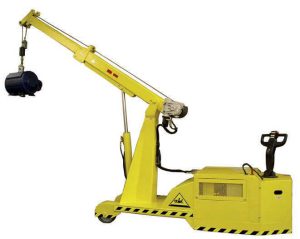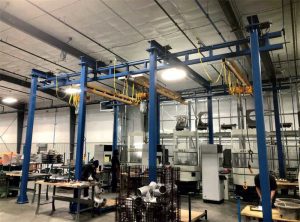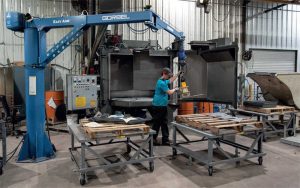All eyes have been on the USA; its pandemic response and its election have disrupted business and made forecasting and planning more than problematic. How has the market for lifting gear coped? And will 2021 be easier? Julian Champkin reports.
It has, of course, been an exceptional year. Bizarre, unexpected, unsettling, extraordinary—a dozen more adjectives would fail to cover it. But businesses have had to try to continue, despite uncertainties—political, economic and of course in public health—each one of which is almost unprecedented. Any election year brings the unknown. This one has been far stranger, and far more significant, than most. Those trying to chart a way forward are facing what you could with justice call a perfect storm.
Let us talk first of demand: John Paxton is COO and CEO designate of MHI, the body that represents the materials handling industry in America. “Certainly Covid has solidly impacted US manufacturing,” he says, “and it did bring a very sharp and very sudden downturn back in April and May. But it has started to recover fairly quickly. It was a very steep decline, but it has been a steep uptick also.
“Some industries of course were affected more than others. Oil and gas, automotive, and aerospace were hit fairly hard. So overall the hoisting industry will be down quite a significant amount for the year.” “Demand has been on quite a yo-yo this year,” says Vida Novak, vice president of lifting equipment makers Air Technical Industries. “Many industrial markets we serve are in decline. It is not always due to Covid-19 directly, but secondary effects from further down the supply chain are affecting them. Most industrial customers are still active, but they are postponing equipment investments due to the uncertainty.” There are, though, some counterweights to put in the balance: “The industries that are driving the up-side of the demand are distribution centres and, (obviously!) medical equipment.”
Darren Berg is president and COO of Liftomatic, who make below-the-hook drum handling equipment. “Demand is quite soft,” he says, “but with the fourth quarter now nearly half way through there is some purchasing going on. Market conditions are trampled due to Covid and many purchases are just being put on hold to allow companies to hang onto valuable cash reserves.”
“As in most of the world, the pandemic has greatly impacted industries throughout North America,” says Rob Beightol, marketing director of New York-based Gorbel. “While service industries like entertainment and restaurants have likely been the hardest hit, companies that provide equipment to support these industries have struggled as well. From lighting truss and speaker manufacturers for theatres to commercial ovens, all have felt the effects of Covid-19.
“And while some industries have struggled, there is still a general requirement across industries to take the guesswork out of overhead lifting. Prior to Covid-19 one of the biggest challenges among manufacturers was finding skilled workers for many positions. Equipment that is easy to use yet offers multiple ways for workers to be productive continues to be in demand. Education on proper, safe, use of equipment continues to be important.”
“Since the pandemic started to strongly affect the economy, and manufacturing in particular, equipment and technology demand dropped considerably,” says Elyssa Baker, marketing director of G.W. Becker. “The focus was shifted to hold capital investment close to the vest and began instead the recognition of short-term investment in upgrade and repairs.
We are still seeing new equipment is being purchased, but we are definitely seeing significant investment from our customer base in repair and upgrades of equipment they already possess.”
“The US market has been challenging this year, primarily due to Covid-19,” says Dan Beilfuss, Columbus McKinnon’s director of crane sales, Americas. “While essential businesses are investing, capital spending has been delayed or put on hold in many sectors. As more states are returning to work, activity levels are starting to pick up in pharmaceuticals, food and beverage and consumer staples. Entertainment-related businesses and nonessential consumer goods remain soft.
“The current economic conditions certainly have an impact on the industry. Capital spending is being carefully monitored due to Covid and the recent election.”
“Demand varies significantly by market,” says John Lund, VP of sales and marketing for hoist specialists Thern. “Construction and marine continue to be very strong while some capital investments in manufacturing have slowed over uncertainty due to Covid.”
The economy in general is equally non-uniform, he says. “Some businesses have slowed their capital spending, while for others it has been accelerated due to limited human presence giving easier access to sites. It is truly a mixed bag.”
Was everything waiting until after the election? Or is it on pause because of Covid? “I think the correct answer here is yes and yes!” says Baker. “Initially it was on pause because of Covid but approaching election day, the economy was being affected from both Covid and the election— or to be more specific, the politics of this particular election. In a normal election year industry would certainly be affected in one direction or another, but we know we are not in a normal time and the effect is being heavily, and negatively, weighed down by both forces.”
Novak of Air Technical agrees with the double ‘yes’: “We are getting a tremendous amount of ‘wait and see’ because of the election and because of Covid-19 for sure.” But Beightol of Gorbel says: “Normally, in election years there is a bit of a pause on some spending as manufacturers wait for the outcome and determine what policies may impact business. However, nothing about 2020 has been normal, including any noticeable pause on corporate spending.”
“In general, industry seems to be holding up well,” says Bret Lussow, director of business development at HSI cranes, “and demand seems surprisingly steady. There has been some uncertainty in the market with the election but the Covid issues seem to be outweighing the election issues.
Many industries experienced a decline in March and April only to rebound this summer, so I think ‘fluctuation’ is a better term than ‘decline’ here. We have not seen the pause from general industry, in fact we are starting to see big demand to ship by year end. Some of this may be due to political uncertainty and a ‘use before you lose’ mentality.
“Many people are looking to use up their budget money prior to year-end which is boosting current bookings, and that seems to be across general industry rather than specific to any one sector. We are hoping a strong year end push will help boost numbers.”
Products of Chice
So where there is spending, what has it been devoted to? “We are seeing big demand for our NikoRail enclosed track systems,” he says. “While this product isn’t necessarily new to the market our on-line quote tool, the Quotinator, and market responsiveness have earned us some nice business.”
Generally, before Covid kicked in, what you could call the normal demands for automation and control systems were evident: “In large winches, VFDs (variable frequency drives) are in high demand,” says Lund of Thern. “Operators are requiring better and better controls of their lifting and pulling devices and are looking for slow/ controlled starts and stops with the ability to run the load quickly from point to point.
In smaller winches and cranes it is all about portability and getting the job done with products that are rugged yet portable.
“So we have upgraded our Liberty Capstan winch to include an integral swivel base that delivers portable strength for lifting, pulling and tensioning at almost any angle. More importantly, it is quiet, which enhances team communication for increased productivity. Among other uses, it is perfect for elevator shaft and cell tower construction projects. With the product upgrade we have developed a heavy-duty hitch mount for use on vehicles with a 2-inch hitch receiver so that you can use the Thern Liberty Capstan anywhere.”
Air Technical’s new portable jib crane models are proving popular for similar reasons: “Customers are finding a great benefit to this product because they don’t have to pour foundations and permanently anchor the cranes,” says Novak. “Instead they can use them in-place where needed; this is a trend where we have found portable jib cranes filling a definite need. And we are very excited about our new self-erecting overhead crane, which was introduced in 2020 to provide a portable overhead system that can be transported anywhere and used any place. The logic here is actually similar to that for the portable jib crane, but on a much broader scale than moving around a factory floor. The key feature is that it can be stowed in a standard ISO container and shipped anywhere in the world, and then erected on-site, without external equipment and with the simple push of a button. It is primarily aimed at military customers who need heavy lifting equipment in all sorts of field locations, but it also has applications in oil and gas exploration and aerospace.”
How has the market for lifting gear coped? And will 2021 be easier?



没有评论:
发表评论